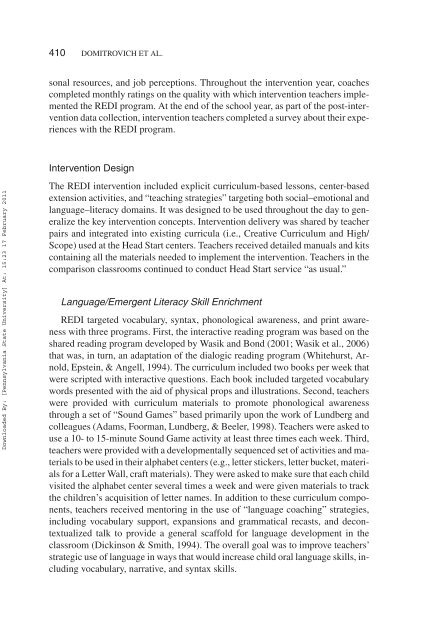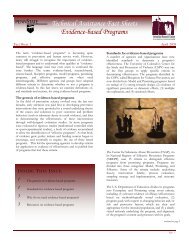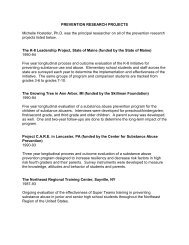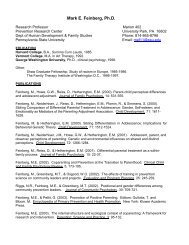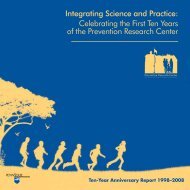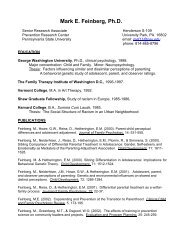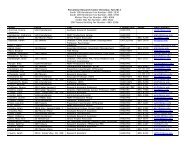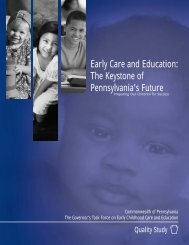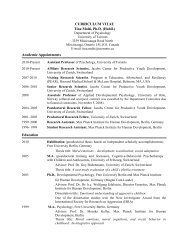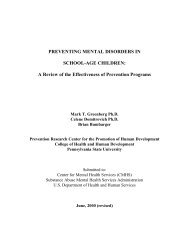Early Education & Development Individual Factors Associated With ...
Early Education & Development Individual Factors Associated With ...
Early Education & Development Individual Factors Associated With ...
Create successful ePaper yourself
Turn your PDF publications into a flip-book with our unique Google optimized e-Paper software.
410 DOMITROVICH ET AL.<br />
sonal resources, and job perceptions. Throughout the intervention year, coaches<br />
completed monthly ratings on the quality with which intervention teachers implemented<br />
the REDI program. At the end of the school year, as part of the post-intervention<br />
data collection, intervention teachers completed a survey about their experiences<br />
with the REDI program.<br />
Downloaded By: [Pennsylvania State University] At: 15:23 17 February 2011<br />
Intervention Design<br />
The REDI intervention included explicit curriculum-based lessons, center-based<br />
extension activities, and “teaching strategies” targeting both social–emotional and<br />
language–literacy domains. It was designed to be used throughout the day to generalize<br />
the key intervention concepts. Intervention delivery was shared by teacher<br />
pairs and integrated into existing curricula (i.e., Creative Curriculum and High/<br />
Scope) used at the Head Start centers. Teachers received detailed manuals and kits<br />
containing all the materials needed to implement the intervention. Teachers in the<br />
comparison classrooms continued to conduct Head Start service “as usual.”<br />
Language/Emergent Literacy Skill Enrichment<br />
REDI targeted vocabulary, syntax, phonological awareness, and print awareness<br />
with three programs. First, the interactive reading program was based on the<br />
shared reading program developed by Wasik and Bond (2001; Wasik et al., 2006)<br />
that was, in turn, an adaptation of the dialogic reading program (Whitehurst, Arnold,<br />
Epstein, & Angell, 1994). The curriculum included two books per week that<br />
were scripted with interactive questions. Each book included targeted vocabulary<br />
words presented with the aid of physical props and illustrations. Second, teachers<br />
were provided with curriculum materials to promote phonological awareness<br />
through a set of “Sound Games” based primarily upon the work of Lundberg and<br />
colleagues (Adams, Foorman, Lundberg, & Beeler, 1998). Teachers were asked to<br />
use a 10- to 15-minute Sound Game activity at least three times each week. Third,<br />
teachers were provided with a developmentally sequenced set of activities and materials<br />
to be used in their alphabet centers (e.g., letter stickers, letter bucket, materials<br />
for a Letter Wall, craft materials). They were asked to make sure that each child<br />
visited the alphabet center several times a week and were given materials to track<br />
the children’s acquisition of letter names. In addition to these curriculum components,<br />
teachers received mentoring in the use of “language coaching” strategies,<br />
including vocabulary support, expansions and grammatical recasts, and decontextualized<br />
talk to provide a general scaffold for language development in the<br />
classroom (Dickinson & Smith, 1994). The overall goal was to improve teachers’<br />
strategic use of language in ways that would increase child oral language skills, including<br />
vocabulary, narrative, and syntax skills.


